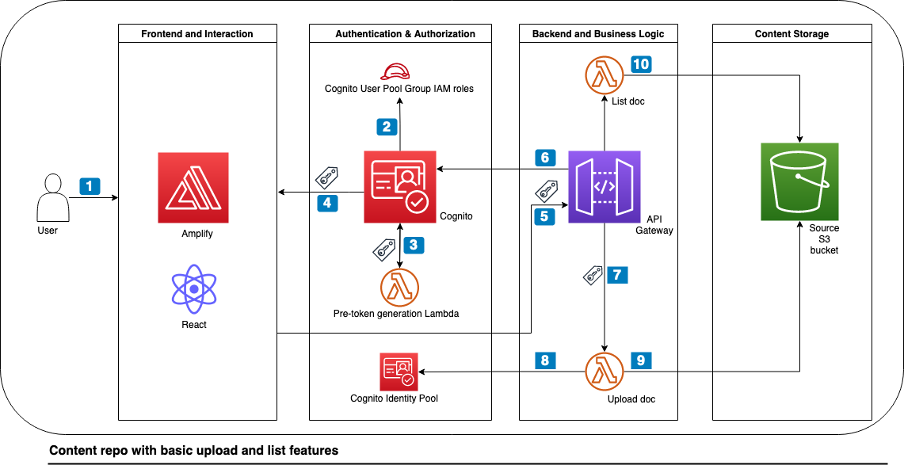AWS Architecture Blog
Category: Amazon Cognito
Converting stateful application to stateless using AWS services
Designing a system to be either stateful or stateless is an important choice with tradeoffs regarding its performance and scalability. In a stateful system, data from one session is carried over to the next. A stateless system doesn’t preserve data between sessions and depends on external entities such as databases or cache to manage state. […]
dApp authentication with Amazon Cognito and Web3 proxy with Amazon API Gateway
If your decentralized application (dApp) must interact directly with AWS services like Amazon S3 or Amazon API Gateway, you must authorize your users by granting them temporary AWS credentials. This solution uses Amazon Cognito in combination with your users’ digital wallet to obtain valid Amazon Cognito identities and temporary AWS credentials for your users. It […]
Content Repository for Unstructured Data with Multilingual Semantic Search: Part 1
Unstructured data can make up to 80 percent of data in the day-to-day business of financial organizations. For example, these organizations typically store and read PDFs and images for claim processing, underwriting, and know your customer (KYC). Organizations need to make this ingested data accessible and searchable across different entities while logically separating data access […]
Web application access control patterns using AWS services
The web application client-server pattern is widely adopted. The access control allows only authorized clients to access the backend server resources by authenticating the client and providing granular-level access based on who the client is. This post focuses on three solution architecture patterns that prevent unauthorized clients from gaining access to web application backend servers. […]
Throttling a tiered, multi-tenant REST API at scale using API Gateway: Part 2
In Part 1 of this blog series, we demonstrated why tiering and throttling become necessary at scale for multi-tenant REST APIs, and explored tiering strategy and throttling with Amazon API Gateway. In this post, Part 2, we will examine tenant isolation strategies at scale with API Gateway and extend the sample code from Part 1. […]
Throttling a tiered, multi-tenant REST API at scale using API Gateway: Part 1
Many software-as-a-service (SaaS) providers adopt throttling as a common technique to protect a distributed system from spikes of inbound traffic that might compromise reliability, reduce throughput, or increase operational cost. Multi-tenant SaaS systems have an additional concern of fairness; excessive traffic from one tenant needs to be selectively throttled without impacting the experience of other […]
Enriching Amazon Cognito features with an Amazon API Gateway proxy
This post was co-written with Geoff Baskwill, member of the Architecture Enabling Team at Trend Micro. At Trend Micro, we use AWS technologies to build secure solutions to help our customers improve their security posture. Sep 6 2022: Amazon Cognito user pools now support native integration with AWS Web Application Firewall (WAF), with this native […]
QsrSoft launches Digital Huddle Board in 3 months with AWS serverless and Fire devices
QsrSoft is a software as a service (SaaS) company that develops solutions for clients in the restaurant, hospitality, and retail industries to help them achieve operational excellence. QsrSoft has provided these services for more than two decades and now services over 14,000 locations. QsrSoft started using AWS in 2015 and fully migrated all their workloads […]
How UnitedHealth Group Improved Disaster Recovery for Machine-to-Machine Authentication
This blog post was co-authored by Vinodh Kumar Rathnasabapathy, Senior Manager of Software Engineering, UnitedHealth Group. Engineers who use Amazon Cognito for machine-to-machine authentication select a primary Region where they deploy their application infrastructure and the Amazon Cognito authorization endpoint. Amazon Cognito is a highly available service in single Region deployments with a published service-level […]
Codacy Measures Developer Productivity using AWS Serverless
Codacy is a DevOps insights company based in Lisbon, Portugal. Since its launch in 2012, Codacy has helped software development and engineering teams reduce defects, keep technical debt in check, and ship better code, faster. Codacy’s latest product, Pulse, is a service that helps understand and improve the performance of software engineering teams. This includes […]









